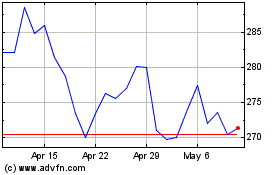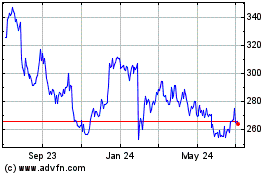Navistar Finds Rough Road To Higher Truck Market Share
February 03 2012 - 8:04AM
Dow Jones News
Navistar's International Corp.'s (NAV) competitors have managed
to plant doubts about Navistar's engines that have held down the
company's market share gains, says Chairman and Chief Executive Dan
Ustian.
Navistar made reaching a 25% share of the heavy-duty commercial
truck market a focal point of its message to Wall Street last year.
Ustian believed the company could grab truck volume by exploiting
rivals' higher truck prices for additional pollution-reduction
components. Navistar opted to use a less expensive exhaust
treatment system, but ended 2011 with a 21.4% market share, up
about four percentage points from the end of 2010.
Ustian said his company has had difficulty fending off rival
truck and engine manufacturers' attacks on the pollution-reduction
technology used on the company's new 13-liter and 15-liter engines.
None of the other truck makers in North America use the same system
for reducing nitrogen oxide in engine exhaust, making Navistar an
easy target for cut-throat comparison marketing by competitors.
Ustian said they've managed to generate enough suspicion and
anxiety about the fuel economy, power and durability of Navistar's
engines to cause trucking companies to be cautious about Navistar
trucks.
"They've put doubt in people's mind," said Ustian during an
interview Wednesday with Dow Jones Newswires. "That part has been
tougher to overcome than we thought. If you're a trucking company,
you may believe our story, but can you take the risk? They've been
reluctant to take that risk. Their livelihood depends on that truck
being right."
Ustian said he's confident that Navistar will eventually be able
to convert more of the market to Navistar trucks as the company's
engines develop a positive track record.
"We've got more work to do in that area" he said.
Navistar is the third-largest seller of heavy-duty trucks in the
North America behind Paccar Inc. (PCAR) and Daimler AG's (DDAIY,
DAI.XE) Freightliner brand. After decades of giving truck buyers a
choice of engine manufacturers, Navistar two years ago decided to
offer only its own engines in its trucks, effectively severing its
relationship with engine maker Cummins Inc. (CMI).
Ustian and other Navistar executives spent Wednesday trying to
ease stock analysts' concerns about Navistar's engines complying
with federal standards for nitrogen oxide emissions. Since 2010 the
company has been using pollution credits to meet with the ultra-low
level prescribed by the U.S. Environmental Protection Agency.
"There's a degree of skepticism regarding how the investment
community has looked at their ability to deliver on their engine
strategy," said Brian Spronheimer, an analyst for Gabelli &
Co., who believes that company's engines will meet the EPA's
standards.
Navistar's stock price is down 33.4% in the past nine months,
despite surging demand for commercial trucks in North America. The
stock Thursday closed up 1.3%, at $45.91 a share.
The company said it has submitted its l3-liter engine for
certification at 0.2-gram of nitrogen oxide per brake-horsepower
hour, the EPA's latest standard. Navistar said it also will soon be
ready to pursue certification for its 15-liter engine. Navistar's
engines have been at about 0.50-gram of nitrogen oxide, which is an
ingredient in greenhouse gas blamed for global warming.
Environmental regulators warned last month that Navistar is
quickly running out of pollution credits for its noncompliant
heavy-duty engines. The EPA established a set of fines for Navistar
to pay in the event that the company exhausts its credits before
its engines are certified. The fines, which could be as much as
$2,000 an engine, would allow Navistar to continue selling its
engines in the U.S.
"I don't like what they determined as the penalties," said
Ustian. "But their intentions are good."
Ustian believes any fines the company pays will be minimal and
short-lived. He insists the company's engines will be able to reach
the 0.20-gram level with exhaust gas recirculation, or ERG. The
process recirculates exhaust through an engine's combustion
process, burning the nitrogen oxide that otherwise would be sent
into the atmosphere from a truck's exhaust pipe. Although
Navistar's EGR engines haven't reached the 0.20-gram standard
previously, the company maintains it has modified the controls on
the system to reach the standard.
Navistar contends ERG is more user-friendly than competitors'
pollution-reduction systems and does not sacrifice fuel economy, a
key argument used against EGR. The rest of the truck industry
reduces nitrogen oxide through a process known as selective
catalytic reduction, or SCR.
SCR filters engine exhaust through a urea solution that turns
nitrogen oxide into water and nitrogen. The system is widely used
on cars and trucks in Europe, but requires truck operators to
maintain a reservoir of urea to keep the system functioning
properly. Navistar has repeatedly complained that EPA's regulations
on SCR permit drivers to operate their trucks for long distances
without sufficient levels of urea, releasing untreated engine
exhaust into the atmosphere.
-By Bob Tita, Dow Jones Newswires; 312 750 4129;
robert.tita@dowjones.com
Rockwell Automation (NYSE:ROK)
Historical Stock Chart
From Aug 2024 to Sep 2024

Rockwell Automation (NYSE:ROK)
Historical Stock Chart
From Sep 2023 to Sep 2024
